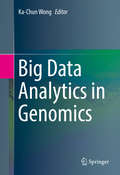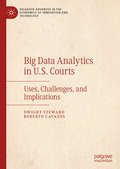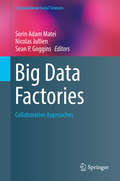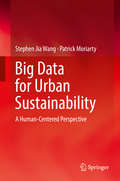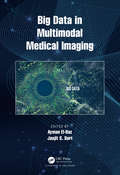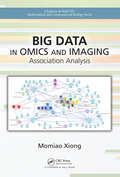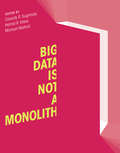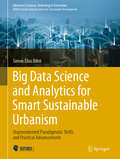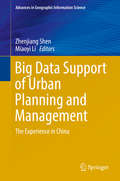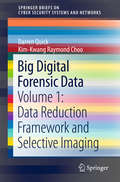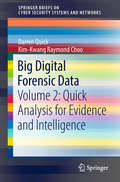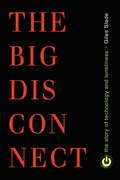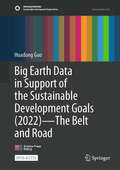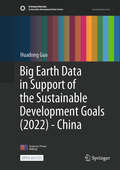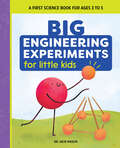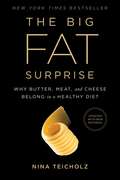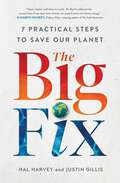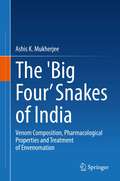- Table View
- List View
Big Data Analytics in Genomics
by Ka-Chun WongThis contributed volume explores the emerging intersection between big data analytics and genomics. Recent sequencing technologies have enabled high-throughput sequencing data generation for genomics resulting in several international projects which have led to massive genomic data accumulation at an unprecedented pace. To reveal novel genomic insights from this data within a reasonable time frame, traditional data analysis methods may not be sufficient or scalable, forcing the need for big data analytics to be developed for genomics. The computational methods addressed in the book are intended to tackle crucial biological questions using big data, and are appropriate for either newcomers or veterans in the field. This volume offers thirteen peer-reviewed contributions, written by international leading experts from different regions, representing Argentina, Brazil, China, France, Germany, Hong Kong, India, Japan, Spain, and the USA. In particular, the book surveys three main areas: statistical analytics, computational analytics, and cancer genome analytics. Sample topics covered include: statistical methods for integrative analysis of genomic data, computation methods for protein function prediction, and perspectives on machine learning techniques in big data mining of cancer. Self-contained and suitable for graduate students, this book is also designed for bioinformaticians, computational biologists, and researchers in communities ranging from genomics, big data, molecular genetics, data mining, biostatistics, biomedical science, cancer research, medical research, and biology to machine learning and computer science. Readers will find this volume to be an essential read for appreciating the role of big data in genomics, making this an invaluable resource for stimulating further research on the topic.
Big Data Analytics in U.S. Courts: Uses, Challenges, and Implications (Palgrave Advances in the Economics of Innovation and Technology)
by Dwight Steward Roberto CavazosThis Palgrave Pivot identifies the key legal, economic, and policy issues surrounding the allowance to use and interpret electronic data consistently and in a scientifically valid manner in U.S. courts. Evidence based on the analysis of large amounts of electronic data ("Big Data") plays an increasing role in civil court disputes, providing information that could not have been obtained from a witness stand. While Big Data evidence presents opportunities, it also presents legal and public policy challenges and concerns. How can one be sure that deviations found in Big Data fall outside the norm? If statistical analyses can be conducted and presented different ways, how can judges and juries make sense of conflicting interpretations? When does Big Data extraction stop being investigative and instead become an invasion of privacy? This book traces the history of Big Data use in U.S. courts, couples current case studies with legal challenges to explore key controversies, and suggests how courts can change the way they handle Big Data to ensure that findings are statistically significant and scientifically sound.
Big Data, Artificial Intelligence, and Data Analytics in Climate Change Research: For Sustainable Development Goals (Advances in Geographical and Environmental Sciences)
by Praveen Kumar Rai Shruti Kanga Suraj Kumar Singh Gaurav Tripathi Achala ShakyaThis book explores the potential of big data, artificial intelligence (AI), and data analytics to address climate change and achieve the Sustainable Development Goals (SDGs). Furthermore, the book covers a wide range of related topics, including climate change data sources, big data analytics techniques, remote sensing, renewable energy, open data, public–private partnerships, ethical and legal issues, and case studies of successful applications. The book also discusses the challenges and opportunities presented by these technologies and provides insights into future research directions.In order to address climate change and achieve the SDGs, it is crucial to understand the complex interplay between climate and environmental factors. The use of big data, AI, and data analytics can play a vital role in this effort by providing the means to collect, process, and analyze vast amounts of environmental data. This book is an essential resource for researchers, policymakers, and practitioners interested in leveraging these technologies to tackle the pressing challenge of climate change and achieve the SDGs.
Big Data Factories: Collaborative Approaches (Computational Social Sciences)
by Sean P. Goggins Sorin Adam Matei Nicolas JullienThe book proposes a systematic approach to big data collection, documentation and development of analytic procedures that foster collaboration on a large scale. This approach, designated as "data factoring" emphasizes the need to think of each individual dataset developed by an individual project as part of a broader data ecosystem, easily accessible and exploitable by parties not directly involved with data collection and documentation. Furthermore, data factoring uses and encourages pre-analytic operations that add value to big data sets, especially recombining and repurposing. The book proposes a research-development agenda that can undergird an ideal data factory approach. Several programmatic chapters discuss specialized issues involved in data factoring (documentation, meta-data specification, building flexible, yet comprehensive data ontologies, usability issues involved in collaborative tools, etc. ). The book also presents case studies for data factoring and processing that can lead to building better scientific collaboration and data sharing strategies and tools. Finally, the book presents the teaching utility of data factoring and the ethical and privacy concerns related to it. Chapter 9 of this book is available open access under a CC BY 4. 0 license at link. springer. com
Big Data for Remote Sensing: Digital Earth And Smart Earth
by Amira S. Ashour Chintan Bhatt Nilanjan DeyThis book thoroughly covers the remote sensing visualization and analysis techniques based on computational imaging and vision in Earth science. Remote sensing is considered a significant information source for monitoring and mapping natural and man-made land through the development of sensor resolutions that committed different Earth observation platforms. The book includes related topics for the different systems, models, and approaches used in the visualization of remote sensing images. It offers flexible and sophisticated solutions for removing uncertainty from the satellite data. It introduces real time big data analytics to derive intelligence systems in enterprise earth science applications. Furthermore, the book integrates statistical concepts with computer-based geographic information systems (GIS). It focuses on image processing techniques for observing data together with uncertainty information raised by spectral, spatial, and positional accuracy of GPS data. The book addresses several advanced improvement models to guide the engineers in developing different remote sensing visualization and analysis schemes. Highlights on the advanced improvement models of the supervised/unsupervised classification algorithms, support vector machines, artificial neural networks, fuzzy logic, decision-making algorithms, and Time Series Model and Forecasting are addressed. This book guides engineers, designers, and researchers to exploit the intrinsic design remote sensing systems. The book gathers remarkable material from an international experts' panel to guide the readers during the development of earth big data analytics and their challenges.
Big Data for Urban Sustainability
by Stephen Jia Wang Patrick MoriartyThis book presents a practical framework for the application of big data, cloud, and pervasive and complex systems to sustainable solutions for urban environmental challenges. It covers the technologies, potential, and possible and impact of big data on energy efficiency and the urban environment.The book first introduces key aspects of big data, cloud services, pervasive computing, and mobile technologies from a pragmatic design perspective, including sample open source firmware. Cloud services, mobile and embedded platforms, interfaces, operating system design methods, networking, and middleware are all considered. The authors then explore in detail the framework, design principles, architecture and key components of developing energy systems to support sustainable urban environments. The included case study provides a pathway to improve the eco-efficiency of urban transport, demonstrating how to design an energy efficient next generation urban navigation system by leveraging vast cloud data sets on user-behavior. Ultimately, this resource maps big data’s pivotal intersection with rapid global urbanization along the path to a sustainable future.
Big Data in Context: Legal, Social and Technological Insights (SpringerBriefs in Law)
by Thomas Hoeren Barbara Kolany-RaiserThis book is open access under a CC BY 4. 0 license. This book sheds new light on a selection of big data scenarios from an interdisciplinary perspective. It features legal, sociological and economic approaches to fundamental big data topics such as privacy, data quality and the ECJ's Safe Harbor decision on the one hand, and practical applications such as smart cars, wearables and web tracking on the other. Addressing the interests of researchers and practitioners alike, it provides a comprehensive overview of and introduction to the emerging challenges regarding big data. All contributions are based on papers submitted in connection with ABIDA (Assessing Big Data), an interdisciplinary research project exploring the societal aspects of big data and funded by the German Federal Ministry of Education and Research. This volume was produced as a part of the ABIDA project (Assessing Big Data, 01IS15016A-F). ABIDA is a four-year collaborative project funded by the Federal Ministry of Education and Research. However the views and opinions expressed in this book reflect only the authors' point of view and not necessarily those of all members of the ABIDA project or the Federal Ministry of Education and Research.
Big Data in Medical Image Processing
by R. Suganya S. Rajaram A. Sheik AbdullahThe field of medical imaging seen rapid development over the last two decades and has consequently revolutionized the way in which modern medicine is practiced. Diseases and their symptoms are constantly changing therefore continuous updating is necessary for the data to be relevant. Diseases fall into different categories, even a small difference in symptoms may result in categorising it in a different group altogether. Thus analysing data accurately is of critical importance. This book concentrates on diagnosing diseases like cancer or tumor from different modalities of images. This book is divided into the following domains: Importance of big data in medical imaging, pre-processing, image registration, feature extraction, classification and retrieval. It is further supplemented by the medical analyst for a continuous treatment process. The book provides an automated system that could retrieve images based on user’s interest to a point of providing decision support. It will help medical analysts to take informed decisions before planning treatment and surgery. It will also be useful to researchers who are working in problems involved in medical imaging.
Big Data in Multimodal Medical Imaging
by Ayman El-Baz Jasjit S. SuriThere is an urgent need to develop and integrate new statistical, mathematical, visualization, and computational models with the ability to analyze Big Data in order to retrieve useful information to aid clinicians in accurately diagnosing and treating patients. The main focus of this book is to review and summarize state-of-the-art big data and deep learning approaches to analyze and integrate multiple data types for the creation of a decision matrix to aid clinicians in the early diagnosis and identification of high risk patients for human diseases and disorders. Leading researchers will contribute original research book chapters analyzing efforts to solve these important problems.
Big Data in Omics and Imaging: Association Analysis (Chapman & Hall/CRC Mathematical and Computational Biology)
by Momiao XiongBig Data in Omics and Imaging: Association Analysis addresses the recent development of association analysis and machine learning for both population and family genomic data in sequencing era. It is unique in that it presents both hypothesis testing and a data mining approach to holistically dissecting the genetic structure of complex traits and to designing efficient strategies for precision medicine. The general frameworks for association analysis and machine learning, developed in the text, can be applied to genomic, epigenomic and imaging data. FEATURES Bridges the gap between the traditional statistical methods and computational tools for small genetic and epigenetic data analysis and the modern advanced statistical methods for big data Provides tools for high dimensional data reduction Discusses searching algorithms for model and variable selection including randomization algorithms, Proximal methods and matrix subset selection Provides real-world examples and case studies Will have an accompanying website with R code The book is designed for graduate students and researchers in genomics, bioinformatics, and data science. It represents the paradigm shift of genetic studies of complex diseases– from shallow to deep genomic analysis, from low-dimensional to high dimensional, multivariate to functional data analysis with next-generation sequencing (NGS) data, and from homogeneous populations to heterogeneous population and pedigree data analysis. Topics covered are: advanced matrix theory, convex optimization algorithms, generalized low rank models, functional data analysis techniques, deep learning principle and machine learning methods for modern association, interaction, pathway and network analysis of rare and common variants, biomarker identification, disease risk and drug response prediction.
Big Data in Radiation Oncology (Imaging in Medical Diagnosis and Therapy)
by Jun Deng and Lei XingBig Data in Radiation Oncology gives readers an in-depth look into how big data is having an impact on the clinical care of cancer patients. While basic principles and key analytical and processing techniques are introduced in the early chapters, the rest of the book turns to clinical applications, in particular for cancer registries, informatics, radiomics, radiogenomics, patient safety and quality of care, patient-reported outcomes, comparative effectiveness, treatment planning, and clinical decision-making. More features of the book are: Offers the first focused treatment of the role of big data in the clinic and its impact on radiation therapy. Covers applications in cancer registry, radiomics, patient safety, quality of care, treatment planning, decision making, and other key areas. Discusses the fundamental principles and techniques for processing and analysis of big data. Address the use of big data in cancer prevention, detection, prognosis, and management. Provides practical guidance on implementation for clinicians and other stakeholders. Dr. Jun Deng is a professor at the Department of Therapeutic Radiology of Yale University School of Medicine and an ABR board certified medical physicist at Yale-New Haven Hospital. He has received numerous honors and awards such as Fellow of Institute of Physics in 2004, AAPM Medical Physics Travel Grant in 2008, ASTRO IGRT Symposium Travel Grant in 2009, AAPM-IPEM Medical Physics Travel Grant in 2011, and Fellow of AAPM in 2013. Lei Xing, Ph.D., is the Jacob Haimson Professor of Medical Physics and Director of Medical Physics Division of Radiation Oncology Department at Stanford University. His research has been focused on inverse treatment planning, tomographic image reconstruction, CT, optical and PET imaging instrumentations, image guided interventions, nanomedicine, and applications of molecular imaging in radiation oncology. Dr. Xing is on the editorial boards of a number of journals in radiation physics and medical imaging, and is recipient of numerous awards, including the American Cancer Society Research Scholar Award, The Whitaker Foundation Grant Award, and a Max Planck Institute Fellowship.
Big Data Is Not a Monolith (Information Policy)
by Cassidy R. Sugimoto Hamid R. Ekbia Michael MattioliPerspectives on the varied challenges posed by big data for health, science, law, commerce, and politics.Big data is ubiquitous but heterogeneous. Big data can be used to tally clicks and traffic on web pages, find patterns in stock trades, track consumer preferences, identify linguistic correlations in large corpuses of texts. This book examines big data not as an undifferentiated whole but contextually, investigating the varied challenges posed by big data for health, science, law, commerce, and politics. Taken together, the chapters reveal a complex set of problems, practices, and policies.The advent of big data methodologies has challenged the theory-driven approach to scientific knowledge in favor of a data-driven one. Social media platforms and self-tracking tools change the way we see ourselves and others. The collection of data by corporations and government threatens privacy while promoting transparency. Meanwhile, politicians, policy makers, and ethicists are ill-prepared to deal with big data's ramifications. The contributors look at big data's effect on individuals as it exerts social control through monitoring, mining, and manipulation; big data and society, examining both its empowering and its constraining effects; big data and science, considering issues of data governance, provenance, reuse, and trust; and big data and organizations, discussing data responsibility, “data harm,” and decision making.ContributorsRyan Abbott, Cristina Alaimo, Kent R. Anderson, Mark Andrejevic, Diane E. Bailey, Mike Bailey, Mark Burdon, Fred H. Cate, Jorge L. Contreras, Simon DeDeo, Hamid R. Ekbia, Allison Goodwell, Jannis Kallinikos, Inna Kouper, M. Lynne Markus, Michael Mattioli, Paul Ohm, Scott Peppet, Beth Plale, Jason Portenoy, Julie Rennecker, Katie Shilton, Dan Sholler, Cassidy R. Sugimoto, Isuru Suriarachchi, Jevin D. West
Big Data Science and Analytics for Smart Sustainable Urbanism: Unprecedented Paradigmatic Shifts and Practical Advancements (Advances in Science, Technology & Innovation)
by Simon Elias BibriWe are living at the dawn of what has been termed ‘the fourth paradigm of science,’ a scientific revolution that is marked by both the emergence of big data science and analytics, and by the increasing adoption of the underlying technologies in scientific and scholarly research practices. Everything about science development or knowledge production is fundamentally changing thanks to the ever-increasing deluge of data. This is the primary fuel of the new age, which powerful computational processes or analytics algorithms are using to generate valuable knowledge for enhanced decision-making, and deep insights pertaining to a wide variety of practical uses and applications. This book addresses the complex interplay of the scientific, technological, and social dimensions of the city, and what it entails in terms of the systemic implications for smart sustainable urbanism. In concrete terms, it explores the interdisciplinary and transdisciplinary field of smart sustainable urbanism and the unprecedented paradigmatic shifts and practical advances it is undergoing in light of big data science and analytics. This new era of science and technology embodies an unprecedentedly transformative and constitutive power—manifested not only in the form of revolutionizing science and transforming knowledge, but also in advancing social practices, producing new discourses, catalyzing major shifts, and fostering societal transitions. Of particular relevance, it is instigating a massive change in the way both smart cities and sustainable cities are studied and understood, and in how they are planned, designed, operated, managed, and governed in the face of urbanization. This relates to what has been dubbed data-driven smart sustainable urbanism, an emerging approach based on a computational understanding of city systems and processes that reduces urban life to logical and algorithmic rules and procedures, while also harnessing urban big data to provide a more holistic and integrated view or synoptic intelligence of the city. This is increasingly being directed towards improving, advancing, and maintaining the contribution of both sustainable cities and smart cities to the goals of sustainable development. This timely and multifaceted book is aimed at a broad readership. As such, it will appeal to urban scientists, data scientists, urbanists, planners, engineers, designers, policymakers, philosophers of science, and futurists, as well as all readers interested in an overview of the pivotal role of big data science and analytics in advancing every academic discipline and social practice concerned with data–intensive science and its application, particularly in relation to sustainability.
Big Data Support of Urban Planning and Management: The Experience in China (Advances in Geographic Information Science)
by Zhenjiang Shen Miaoyi LiIn the era of big data, this book explores the new challenges of urban-rural planning and management from a practical perspective based on a multidisciplinary project. Researchers as contributors to this book have accomplished their projects by using big data and relevant data mining technologies for investigating the possibilities of big data, such as that obtained through cell phones, social network systems and smart cards instead of conventional survey data for urban planning support. This book showcases active researchers who share their experiences and ideas on human mobility, accessibility and recognition of places, connectivity of transportation and urban structure in order to provide effective analytic and forecasting tools for smart city planning and design solutions in China.
Big Digital Forensic Data: Volume 2: Quick Analysis For Evidence And Intelligence (SpringerBriefs On Cyber Security Systems And Networks)
by Kim-Kwang Raymond Choo Darren QuickThis book provides an in-depth understanding of big data challenges to digital forensic investigations, also known as big digital forensic data. It also develops the basis of using data mining in big forensic data analysis, including data reduction, knowledge management, intelligence, and data mining principles to achieve faster analysis in digital forensic investigations. By collecting and assembling a corpus of test data from a range of devices in the real world, it outlines a process of big data reduction, and evidence and intelligence extraction methods. Further, it includes the experimental results on vast volumes of real digital forensic data. The book is a valuable resource for digital forensic practitioners, researchers in big data, cyber threat hunting and intelligence, data mining and other related areas.
Big Digital Forensic Data: Volume 2: Quick Analysis for Evidence and Intelligence (SpringerBriefs on Cyber Security Systems and Networks)
by Darren Quick Kim-Kwang Raymond ChooThis book provides an in-depth understanding of big data challenges to digital forensic investigations, also known as big digital forensic data. It also develops the basis of using data mining in big forensic data analysis, including data reduction, knowledge management, intelligence, and data mining principles to achieve faster analysis in digital forensic investigations. By collecting and assembling a corpus of test data from a range of devices in the real world, it outlines a process of big digital forensic data analysis for evidence and intelligence. It includes the results of experiments on vast volumes of real digital forensic data. The book is a valuable resource for digital forensic practitioners, researchers in big data, cyber threat hunting and intelligence, data mining and other related areas.
The Big Dipper (Let's-read-and-find-out Science 1 Ser.)
by Franklyn M. BranleyExplains basic facts about the Big Dipper, including which stars make up the constellation, how its position changes in the sky, and how it points to the North Star.
Big Disconnect
by Giles SladeSmart phones and social media sites may be contemporary fixations, but using technology to replace face-to-face interactions is not a new cultural phenomenon. Throughout our history, intimacy with machines has often supplanted mutual human connection. This book reveals how consumer technologies changed from analgesic devices that soothed the loneliness of a newly urban generation to prosthetic interfaces that act as substitutes for companionship in modern America. The history of this transformation helps explain why we use technology to mediate our connections with other human beings instead of seeking out face-to-face contact. Do electronic interfaces receive most of our attention to the detriment of real interpersonal communication? Why do sixty million Americans report that isolation and loneliness are major sources of unhappiness? The author provides many insights into our increasingly artificial relationships and a vision for how we can rediscover genuine community and human empathy.
Big Earth Data in Support of the Sustainable Development Goals (Sustainable Development Goals Series)
by Huadong GuoThis open access book showcases the innovative practices of Big Earth Data methods through a collection of global comprehensive case studies to monitor and evaluate indicators for seven SDGs, i.e., zero hunger (SDG 2), clean water and sanitation (SDG 6), affordable and clean energy (SDG 7), sustainable cities and communities (SDG 11), climate action (SDG 13), life below water (SDG 14), life on land (SDG 15), and to analyzes the interactions among multiple SDGs indicators. The emphasis on Big Earth Data is highly relevant within the context of growing global challenges. Disaster risk mitigation, climate change, global food security, resource management, and environmental challenges all are interlinked through earth systems and processes that are independent of human constructs. Therefore these case studies highlight methods and practices of spatial information mining and integrated SDG evaluation, which include evaluating the synergy and trade-off relationships among the SDGs in the context of their correlations; simulating multiple indicators’ interactions in environmental, economic, and social scenarios in the context of their temporal variations; designing integrated evaluations of regional SDGs in the context of experience with the study of multiple indicators. Big Earth Data therefore has the potential to support informed policy and decision support at global, regional, and local scales.
Big Earth Data in Support of the Sustainable Development Goals (Sustainable Development Goals Series)
by Huadong GuoThis open access book showcases the innovative practices of Big Earth Data methods through a collection of comprehensive case studies from China to monitor and evaluate indicators for seven SDGs, i.e., zero hunger (SDG 2), clean water and sanitation (SDG 6), affordable and clean energy (SDG 7), sustainable cities and communities (SDG 11), climate action (SDG 13), life below water (SDG 14), life on land (SDG 15), and to analyze the interactions among multiple SDGs indicators. The emphasis on Big Earth Data is highly relevant within the context of growing global challenges. Disaster risk mitigation, climate change, global food security, resource management, and environmental challenges all are interlinked through earth systems and processes that are independent of human constructs. Therefore, these case studies highlight methods and practices of spatial information mining and integrated SDG evaluation, which include evaluating the synergy and trade-off relationships among the SDGs in the context of their correlations; simulating multiple indicators’ interactions in future environmental, economic and social scenarios in the context of their temporal variations; designing integrated evaluations of regional SDGs in the context of experience with the study of multiple indicators. Big Earth Data therefore has the potential to support informed policy and decision support at global, regional, and local scales.
Big Engineering Experiments for Little Kids: A First Science Book for Ages 3 to 5 (Big Experiments for Little Kids)
by Dr. Jacie MaslykExciting engineering experiments for kids ages 3 to 5 Kids are curious about how stuff works! They like to ask questions, come up with ideas, and try things out for themselves. Big Engineering Experiments for Little Kids helps activate their imaginations and shows them real engineering in action. When STEAM learning starts early, kids can prepare for scholastic success and a lifelong habit of creative and analytical thinking. Dive into engineering for kids with: 20 kid-friendly experiments—With some basic household items, kids can build a spaghetti bridge, construct a flying paper airplane, and feel how sound travels through their body! Easy instructions—These experiments are simple enough for kids to do with just a little help from a grownup, so they can practice independent learning. Engineering exploration—Each experiment shows off a different facet of engineering for kids, with explanations and thoughtful questions that illustrate how it works. Encourage little ones to explore the workings of the world with a fun book of activities that explore engineering for kids.
The Big Fat Surprise: Why Butter, Meat and Cheese Belong in a Healthy Diet
by Nina TeicholzA New York Times bestseller Named one of The Economist's Books of the Year 2014 Named one of The Wall Street Journal's Top Ten Best Nonfiction Books of 2014 Kirkus Reviews Best Nonfiction Books of 2014 Forbes's Most Memorable Healthcare Book of 2014 In The Big Fat Surprise, investigative journalist Nina Teicholz reveals the unthinkable: that everything we thought we knew about dietary fat is wrong. She documents how the low-fat nutrition advice of the past sixty years has amounted to a vast uncontrolled experiment on the entire population, with disastrous consequences for our health.For decades, we have been told that the best possible diet involves cutting back on fat, especially saturated fat, and that if we are not getting healthier or thinner it must be because we are not trying hard enough. But what if the low-fat diet is itself the problem? What if the very foods we've been denying ourselves--the creamy cheeses, the sizzling steaks--are themselves the key to reversing the epidemics of obesity, diabetes, and heart disease? In this captivating, vibrant, and convincing narrative, based on a nine-year-long investigation, Teicholz shows how the misinformation about saturated fats took hold in the scientific community and the public imagination, and how recent findings have overturned these beliefs. She explains why the Mediterranean Diet is not the healthiest, and how we might be replacing trans fats with something even worse. This startling history demonstrates how nutrition science has gotten it so wrong: how overzealous researchers, through a combination of ego, bias, and premature institutional consensus, have allowed dangerous misrepresentations to become dietary dogma. With eye-opening scientific rigor, The Big Fat Surprise upends the conventional wisdom about all fats with the groundbreaking claim that more, not less, dietary fat--including saturated fat--is what leads to better health and wellness. Science shows that we have been needlessly avoiding meat, cheese, whole milk, and eggs for decades and that we can now, guilt-free, welcome these delicious foods back into our lives.
The Big Fix: Seven Practical Steps to Save Our Planet
by Hal Harvey Justin GillisAn engaging, accessible citizen&’s guide to the seven urgent changes that will really make a difference for our climate—and how we can hold our governments accountable for putting these plans into action.Dozens of kids in Montgomery County, Maryland, agitated until their school board committed to electric school buses. Mothers in Colorado turned up in front of an obscure state panel to fight for clean air. If you think the only thing you can do to combat climate change is to install a smart thermostat or cook plant-based burgers, you&’re thinking too small. That&’s where The Big Fix comes in, offering everyday citizens a guide to the seven essential changes our communities must enact to bring our greenhouse gas emissions down to zero—and sharing stories of people who are making those changes reality. Energy policy advisor Hal Harvey and longtime New York Times reporter Justin Gillis hone in on the seven areas where ambitious but eminently practical changes will have the greatest effect: electricity production, transportation, buildings, industry, urbanization, use of land, and investment in promising new green technologies. In a lively, jargon-free style, the pair illuminate how our political economy really works, revealing who decides everything from what kind of power plants to build to how efficient cars must be before they&’re allowed on the road to how much insulation a new house requires—and how we can insert ourselves into all these decisions to ensure that the most climate-conscious choices are being made. At once pragmatic and inspiring, The Big Fix is an indispensable action plan for citizens looking to drive our country&’s greenhouse gas emissions down to zero—and save our climate.
The 'Big Four’ Snakes of India: Venom Composition, Pharmacological Properties and Treatment of Envenomation
by Ashis K. MukherjeeThis book provides detailed and updated knowledge about medically important ‘Big Four’ venomous snakes of India (Indian spectacled cobra, Indian common krait, Indian Russell’s viper, and Indian saw-scaled viper). This book essentially covers the snakebite problem in the world with particular reference to Asia and India. It discusses the evolution and systematics of venomous snakes, emphasizing ‘Big Four’ venomous snakes of India; the evolution and composition of venoms determined by traditional biochemical and modern proteomic analyses. It also describes the pharmacological properties of enzymatic and non-enzymatic toxins of ‘Big Four’ venomous snakes of India. Different chapters discuss exciting topics such as species-specific and geographical differences in venom composition and its impact on pathophysiology and clinical manifestations of snakebite envenomation in India, biomedical application of Indian snake venom toxins; production and quality assessment of commercial antivenom, prevention, and treatment of snakebite in India, adverse effects of antivenom including strategies to combat antivenom reactions inpatient.This book caters to toxinologists, pharmacologists, zoologists, antivenom manufacturers, biochemists, clinicians, evolutionary biologists, herpetologists, and informed non-specialists interested to know about the Indian snake venoms.
